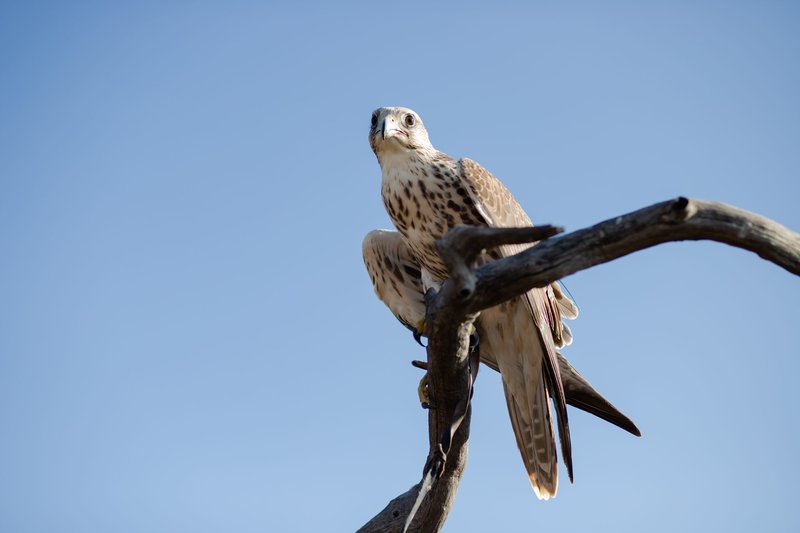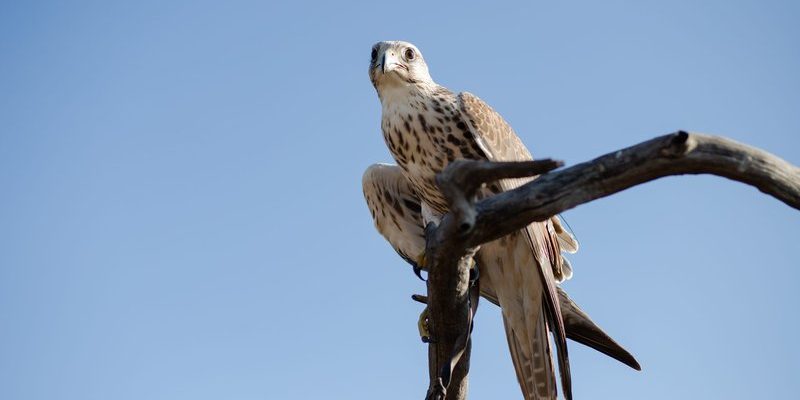
In this article, we’ll explore how Saker falcons have evolved to fit seamlessly into their environments. This majestic bird, known for its impressive speed and hunting prowess, offers a prime example of nature at work. So, let’s dive into the world of Saker falcons and uncover the secrets behind their adaptability!
Physical Adaptations: Built for the Sky
One of the most striking aspects of Saker falcons is their physical adaptations, which are specifically designed for flight and hunting. These birds boast long, pointed wings that allow them to soar through the air with incredible agility. Think of their wings as sleek, aerodynamic tools crafted by nature, helping them cover vast distances while searching for prey.
Another notable feature is their keen eyesight. Saker falcons can spot a mouse from over a mile away! Their eyes are specially adapted with a high density of photoreceptor cells, allowing them to see in sharp detail even in low light. This extraordinary vision is crucial for hunting, enabling them to identify potential food sources while soaring high above the ground.
Moreover, their strong beaks and talons are essential for catching and consuming prey. The beak is hooked, making it easy to tear apart meat, while their powerful talons grip their food firmly. This combination of physical traits ensures that Saker falcons are well-equipped to hunt and thrive in diverse environments, whether in open plains or mountainous regions.
Behavioral Adaptations: Smart and Strategic
When it comes to survival, adaptability isn’t just about physical traits; it’s also about behavior. Saker falcons exhibit impressive hunting strategies that highlight their intelligence. Unlike many other bird species that may rely solely on speed, Saker falcons often use a method called “stooping.” This involves diving from great heights to surprise unsuspecting prey below. Picture them as nature’s stealth bombers—rapidly descending with precision to catch their meal.
Additionally, Saker falcons are known for their ability to switch their hunting tactics based on the environment. For example, if they find themselves in an area with plenty of small animals, they might hunt during the day when there’s enough light. However, in more arid regions where food is scarce, they may adapt by hunting at dawn or dusk when their prey is more active. This flexibility shows how Saker falcons can think on their feet and adjust their strategies for the best chance of success.
Social behavior also plays a role in their adaptability. During breeding season, Saker falcons often pair up to work together in raising their young. This teamwork helps ensure that their chicks survive in a challenging environment, where food scarcity can pose a significant threat. Their social structures add another layer to their adaptability, helping them navigate their surroundings more effectively.
Habitat Preferences: A Wide Range of Environments
Saker falcons are incredibly versatile when it comes to their habitat preferences. You might find them in open grasslands, steppes, and even mountainous areas. This adaptability allows them to thrive in various climates—from hot, arid regions to cooler, more temperate zones.
Their choice of habitat often reflects their hunting needs. For instance, in wide-open plains, these birds can scan for prey from above, taking advantage of their speed and hunting skills. In contrast, when nesting in more rugged terrains, they may exploit natural crevices or cliffs, which provide safety from predators and a good vantage point for hunting.
Interestingly, Saker falcons also respond to changes in their habitats, such as human encroachment or agricultural expansion. They often adjust their nesting and hunting strategies accordingly, showcasing their ability to coexist with humans and adapt to new conditions. For example, some Saker falcons have been observed hunting near farmlands, where they take advantage of the abundance of rodents attracted to crops.
Dietary Flexibility: Eating What’s Available
The Saker falcon’s diet is a significant aspect of its adaptability. These birds are not picky eaters; they consume various prey, including small mammals, birds, and even insects. This dietary flexibility is crucial for survival, especially in changing environments where food sources may fluctuate.
For example, if conditions in one area lead to a decrease in small mammals, Saker falcons can quickly pivot to hunt birds or other available prey. This ability to switch up their menu means they’re less likely to go hungry, no matter what challenges arise in their environment. It’s like being a chef who can whip up a meal from whatever ingredients are on hand!
Furthermore, Saker falcons have developed hunting techniques that cater to the specific types of prey they seek. They might use different approaches for catching a fast-moving bird compared to a slower mammal, showcasing their intelligence and adaptability in the field.
Migration and Seasonal Adaptations
Migration is another fascinating aspect of the Saker falcon’s adaptability. While not all Saker falcons migrate, many do so to escape harsh winter conditions. They travel thousands of miles to find warmer climates with abundant food sources.
During migration, these birds display remarkable stamina and endurance. They can fly long distances without stopping, relying on their strong wings and keen navigational skills. It’s like a long-distance runner who knows when to conserve energy and when to sprint for the finish line!
Moreover, during seasonal changes, Saker falcons adapt their behavior to cope with food shortages. In winter, when prey is scarce, they might change their hunting times or even seek communal roosting spots with other birds. This social behavior not only helps them stay warm but also increases their chances of finding food, showcasing the importance of adaptability in their survival.
Challenges and Conservation: Adapting to Human Impact
Despite their impressive adaptability, Saker falcons face numerous challenges in the modern world. Habitat loss due to agriculture, urbanization, and climate change poses significant threats to their populations. As natural habitats are destroyed, these birds must adapt even more quickly to survive.
Conservation efforts are crucial in helping Saker falcons thrive despite these challenges. By establishing protected areas and promoting sustainable practices, we can help ensure that these majestic birds have safe environments to live and hunt. It’s like creating a safe haven where they can continue their incredible journey of adaptation.
Raising awareness about the importance of Saker falcons and their role in the ecosystem is vital. Educating communities about responsible land use and protecting their habitats can make all the difference in ensuring that these remarkable birds continue to thrive for generations to come.
The Saker falcon is a true marvel of nature, displaying incredible adaptability that allows it to thrive in various environments. From their impressive physical traits to their strategic hunting behavior, these birds remind us how life continuously evolves in response to challenges. They not only adapt to their surroundings but also find ways to coexist with the ever-changing human world.
As we learn more about Saker falcons, let’s appreciate the beauty of their adaptability. It highlights the intricate balance of nature and the importance of conserving these magnificent creatures and their habitats. After all, the more we understand and protect Saker falcons, the more we can ensure that they continue to soar through our skies for years to come.

